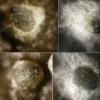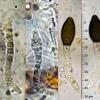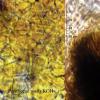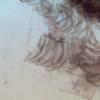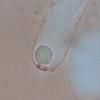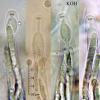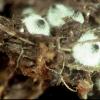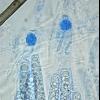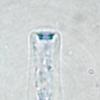
21-12-2025 09:32
Hello.A tiny ascomycete found embedded in wood in

21-12-2025 21:32
Pol DebaenstHello, Garden, Burgweg 19, Veurne, BelgiumOn 10/1

22-12-2025 23:38
Patrice TANCHAUDBonsoir, récolte sur un mur en pierre, apothéci

22-12-2025 00:47
Patrice TANCHAUDBonsoir, récolte à proximité du milieu dunaire

21-12-2025 21:40
Isabelle CharissouBonjour, j'aimerais connaitre les références de

21-12-2025 21:31
Pol DebaenstHello, Garden, Burgweg 19, Veurne, BelgiumOn 10/1

21-12-2025 21:31
Pol DebaenstHello, Garden, Burgweg 19, Veurne, BelgiumOn 10/1

20-12-2025 23:08
Patrice TANCHAUDBonsoir, récolte sur sol sablonneux dans l'arri�
Cercophora-Inmersiella
Enrique Rubio,
15-04-2009 21:15
J'ai trouvé sur bois tres degradée ces petits peritheces, non inmergées, tous ils couverts de poils hyalines jusqu'a l'ostiole. La morphologie des spores et ses changes me parlent de Cercophora caudata (= Inmersiella c.).
Connaisez vous s'il est possible cette couveture blanche dans cet spece? Je n'ai trouvé dans la literature acune reference a cet caracter.
Merci en avancé
Enrique
Enrique Rubio,
15-04-2009 21:16
Peter Welt,
15-04-2009 21:50
Jacques Fournier,
15-04-2009 22:48

Re:Cercophora-Inmersiella
Hi Enrique,
I suppose it is Lasiosphaeria lanuginosa species complex. If yes asci have an apical globulus and the perithecial content is yellow, like in L. ovina.
The transfer from Cercophora to Lasiosphaeria has been made by Andrew based on wall anatomy and molecular work. I guess he will tell us his opinion soon.
Good night,
Jacques
I suppose it is Lasiosphaeria lanuginosa species complex. If yes asci have an apical globulus and the perithecial content is yellow, like in L. ovina.
The transfer from Cercophora to Lasiosphaeria has been made by Andrew based on wall anatomy and molecular work. I guess he will tell us his opinion soon.
Good night,
Jacques
Peter Welt,
16-04-2009 10:03

Re:Cercophora-Inmersiella
Hi Jacques,
This combination of Miller & Huhndorf I can not accept. Since when Lasiosphaeria gets a brown spores head? Look at the work on the family tree. Then, according to my view Cercophora and Lasiosphaeria to a genus should be merged. Sure, the classes are very close, but how do we then still fungi determine if we can not be separated after more microscopic features can make? These studies are for me only a half truth and out of context.
Peter
This combination of Miller & Huhndorf I can not accept. Since when Lasiosphaeria gets a brown spores head? Look at the work on the family tree. Then, according to my view Cercophora and Lasiosphaeria to a genus should be merged. Sure, the classes are very close, but how do we then still fungi determine if we can not be separated after more microscopic features can make? These studies are for me only a half truth and out of context.
Peter
Jacques Fournier,
16-04-2009 11:31

Re:Cercophora-Inmersiella
Hi Peter,
In contrast with species, genera do not exist out of man's mind, thus they are a very subjective matter and I respect your point of view. Miller's hypothesis is that the wall structure is more informative than spore morphology. In his mind Cercophora as currently understood is likewise very heterogenous.Time will tell if it is sound or not.
Jacques
In contrast with species, genera do not exist out of man's mind, thus they are a very subjective matter and I respect your point of view. Miller's hypothesis is that the wall structure is more informative than spore morphology. In his mind Cercophora as currently understood is likewise very heterogenous.Time will tell if it is sound or not.
Jacques
Peter Welt,
16-04-2009 13:22

Re:Cercophora-Inmersiella
Thanks for your answer. I believe we must first ask what we want. It is important for me that we can determine a kind. Whether we are the natural system (and so what we can not find, or tell me in a river where the boundaries are?) Are fairly or not, for me a minor role. I also know that there are always different opinions and will ensure you can here and there to split genera (eg, according to the work of Cai et al (2005) is not a single genus Podospora unlike Schizothecium), but what brings us? I'm not an opponent of the investigations, but with the results, I often doubt, especially in the genres where I am a little familiar.
Peter
Peter
Enrique Rubio,
16-04-2009 17:25
Re:Cercophora-Inmersiella
Thank you Peter and Jacques. Always the eternal question: the genetic analyses are going to help us?.
Unfortunately almost there were no already asci in my collection, and I am not being able to answer to yours questions about them.
Peter: I have not seen squamules on the perithecial necks, but the content is yellowish.
Another question: Could be Cercophora gossypina (a new fimicolous species described by N. Lundq.: Symb. Bot. XX: 107 (1972) a sinonymous ot this species?
Enrique
Unfortunately almost there were no already asci in my collection, and I am not being able to answer to yours questions about them.
Peter: I have not seen squamules on the perithecial necks, but the content is yellowish.
Another question: Could be Cercophora gossypina (a new fimicolous species described by N. Lundq.: Symb. Bot. XX: 107 (1972) a sinonymous ot this species?
Enrique
Jacques Fournier,
16-04-2009 17:43

Re:Cercophora-Inmersiella
Hi Enrique,
I do not know C. gossypina but judging from Lundqvist's detailed description I agree with you they should be closely related. The differences are the yellow tinge of the coating of gossypina, the verrucose subapical globule in gossypina vs smooth in lanuginosa and the fimicolous habitat of gossypina. Otherwise they are much alike.
Jacques
I do not know C. gossypina but judging from Lundqvist's detailed description I agree with you they should be closely related. The differences are the yellow tinge of the coating of gossypina, the verrucose subapical globule in gossypina vs smooth in lanuginosa and the fimicolous habitat of gossypina. Otherwise they are much alike.
Jacques
Peter Welt,
16-04-2009 18:20

Re:Cercophora-Inmersiella
Hi Enrique,
As Jacques has already written in C. gossypina a Globulum exist and the presence of wood would not agree. We have also been fimicole species found on wood.
Peter
As Jacques has already written in C. gossypina a Globulum exist and the presence of wood would not agree. We have also been fimicole species found on wood.
Peter
Enrique Rubio,
16-04-2009 19:13
Re:Cercophora-Inmersiella
Peter. Do you agree too if Lasiosphaeria lanuginosa species complex is a good hypothesis as Jacques suggest?
Enrique Rubio,
16-04-2009 20:44
Peter Welt,
16-04-2009 21:35
Jacques Fournier,
16-04-2009 22:22

Re:Cercophora-Inmersiella
the swollen structure beneath the ring on your photos is not the globule, most likely an artifact due to to KOH. You can see a typical globule in the common L.hirsuta (photo attached). It is best seen when stained, here blue black ink, but it is usually visible in water too. Asci in your collection seem to lack a globule, but try to check it after staining. Any usual stain works.
By the way try to focus on the ring and see whether it is simple or double.
Good luck!
Jacques
By the way try to focus on the ring and see whether it is simple or double.
Good luck!
Jacques
Jacques Fournier,
17-04-2009 08:13
Enrique Rubio,
17-04-2009 18:28
Re:Cercophora-Inmersiella
Thank you Peter and Jacques. I have not seen any apical gobulus in H2O. It seems Cercophora coprophila in Eucalyptus wood!!. There's the craziest things, as Peter says.
Jacques Fournier,
17-04-2009 19:01

Re:Cercophora-Inmersiella
Hi Enrique,
coprophila why not? one should never say never about fungi.
However C. coprophila is not only known to be restricted to dung but specialised on cow dung (Lundqvist 1972) which makes it a doubtful candidate for occurrence on wood.
C. coprophila is distinctive also in that its asci have a double apical ring, this is why I sugested you yesterday to try to see it. You need a very good slide and good optics but iof you see it it is a key feature.
Bets wishes,
Jacques
coprophila why not? one should never say never about fungi.
However C. coprophila is not only known to be restricted to dung but specialised on cow dung (Lundqvist 1972) which makes it a doubtful candidate for occurrence on wood.
C. coprophila is distinctive also in that its asci have a double apical ring, this is why I sugested you yesterday to try to see it. You need a very good slide and good optics but iof you see it it is a key feature.
Bets wishes,
Jacques

